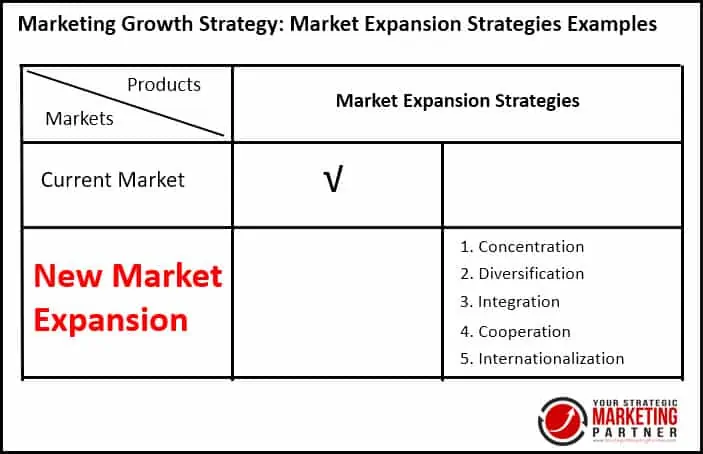101 money saving tips for food businesses to control food costs
If you are looking for cost saving methods to control your food costs, you have come to the right place. […]
Read More »Become a successful marketing consultant: Learn more

If you want to discover strategies to expand your market, you have come to the right place.
In this article, we will review five market expansion strategies and some examples.
Market expansion strategies examples
Five market expansion strategies include: 1. Market expansion through concentration, 2. Market expansion through diversification, 3. Market expansion through integration, 4. Market expansion through cooperation, 5. Market expansion through internationalization.
Market expansion strategies are growth strategies used by entities seeking to make products or services available to new markets when existing markets become saturated.
Let’s now explore these strategies.
A business can expand into more markets by broadening their operations and reviewing customer functions, groups, and technologies.
You can do this with five market expansion strategies. These strategies include market expansion through concentration, diversification, integration, cooperation, and internationalization.
These strategies begin by analyzing current and future distribution channels to create measures meant to boost reach and sales in markets of interest.
The market expansion comes with varying risks and hurdles.
However, market expansion offers many benefits when done correctly. The reasons why companies would want to expand their market are almost endless, but some of the most common reasons include:

There are various ways companies can expand their market.
A market expansion strategy is often referred to as market development.
But the bottom line is this: A market expansion strategy involves expanding the target market in order to increase the number of potential customers, and ultimately, to realize an increase in paid customers.
Here is a simple example of how to expand your market.
First, the definition of marketing is twofold:
With that, a market expansion strategy is always focused on the customer.
Now, for example, let’s assume you own a window and glass repair shop.
Your current target market has 10,000 potential customers in your target market zip code. These 10,000 potential customers are home owners. This is your baseline.
Let’s now assume you have 2,000 paid customers in your database, from this target market.
As a basic benchmark, this means you have a market share of 20%. (There are many ways to measure the market share, but we will keep this example super simple).
But now you and your team decide that you want to increase your sales revenue in order to generate more net income by servicing more customers as a result of expanding your target market.
Now, let’s explore how to apply a market expansion strategy.
One common method of expanding a market is to enter into new geographical area.
In this example, you could do your research and find another target market in an adjacent zip code that has a similar demographic reach with households numbering 10,000 homeowners within a 10-mile radius of your business.
Adding this additional zip code to your target market expands your total market to 20,000 and allows you to generate more sales value by gaining more customers.
Now, since you are targeting new customers who do not know you, your marketing team will need to get to work and market your Unique Selling Proposition to this target market.
To learn how to do this here are four great resources:
This is the first level of market expansion strategies. It involves investing resources in the company’s product line and catering to the needs of an identified market through proven and tested technology.
The strategy involves companies coinciding resources into their businesses to cater to customer functions, needs, and technology alternatives. This is done collectively or individually.
For instance, a company like Apple may choose to invest more resources in its product to cater to an identified target market. The company may create regional customer representatives to cater to the needs of a potential target market in a specific geographic region, thereby increasing sales.
The strategy involves companies changing their business definition by expanding into a new market or developing new products jointly or individually.
Nike is the best example of this expansion strategy since they’ve expanded by creating new products in shoes, apparel, and other sectors of the fashion industry.
Often, companies expand their market through diversification to prepare for economic downturns. This strategy helps offset one business’ losses with another business’ profits. Ideally, one that wasn’t affected by the adverse market conditions.
This strategy involves combining a company’s current operations without changing customer groups. Companies do the combination through a value chain involving interlinked activities performed by an entity.
It involves the procurement of raw materials through the marketing of finished products. The firm may move down or up the value chain to focus on existing customers’ needs.
Two common methods here are “backward integration” and “forward integration”.
Backward and forward integration are strategies used by companies to gain greater control over their production and distribution processes. Backward integration is the process by which a company acquires or forms its own suppliers, either through acquisition or merger.
This gives the company greater control over the quality and delivery of its inputs, as well as more control over the cost of those inputs. It can also help to reduce dependency on external suppliers, reducing the risk of supply chain disruption.
Forward integration is the opposite of backward integration, and involves the company expanding into other areas of the production or distribution process.
For example, a company may acquire its own retail outlets, or a distribution network, in order to better control the sale of its products. This can help the company to capture more of the profits from its products, as it is able to sell them at higher prices without having to pay a third party for distribution. It can also help the company to better control the quality of its products, as it is able to ensure that they are sold and promoted in the right way.
For many years we worked with a company that had about 25 locations in the women's cosmetics industry. This company established a nice distribution system and when the opportunity came up, they purchased their main supplier. This is an example of backwards integration. This also opened up some wholesale B2B opportunities for them.
Expansion through cooperation strategies involves organizations that enter mutual agreements
with competitors to perform business operations and compete simultaneously. Doing this helps expand market potential.
Our team regularly searches for businesses to work with here, ranging from simply buying the business or doing a joint venture. If you or someone you know would like to explore this and have a conversation with our team at Strategic Marketing Partner, we ‘d be delighted to speak with you. Please contact us here.
Companies can achieve market expansion through cooperation with these 4 strategies:
Mergers involve two or more firms where the primary firm acquires its competitors’ assets and liabilities for shares, cash, or both. Both firms get dissolved during the process, creating a third firm that’s bigger than the previous two.
Takeovers involve a firm that acquires another and becomes responsible for the other firm’s operations. The process can be hostile or friendly. In friendly takeovers, both firms agree to cooperate for mutual benefit, while hostile takeovers involve the forceful acquisition of target firms with or without their knowledge.
Joint ventures involve two firms agreeing to work jointly to capitalize on each firm’s strengths. Often, these are temporary and end when both companies achieve the end goal.
This involves an instance where two companies agree to combine or unite to perform various business operations. The firms pursue individualized goals but perform independently. This strategy helps capitalize on either firm’s workforce or technology.
Companies follow this strategy when looking to expand their reach globally. Companies choose this option when they’ve explored all their domestic potential and are looking for opportunities elsewhere.
However, choosing this option is not easy for most companies since they must comply with varying and strict benchmarks of quality, timely delivery, and price when selling their services and products.
Here are two excellent resources about expanding your business thorough international marketing:
What are the Elements of International Marketing? (Answered!)
International Marketing Strategies PDF (Free checklist)
Market expansion is daunting, especially for small-scale companies; however, it can also be quite rewarding. Following the strategies in this article can help you plan your expansion better, taking you one step closer to your business goals.